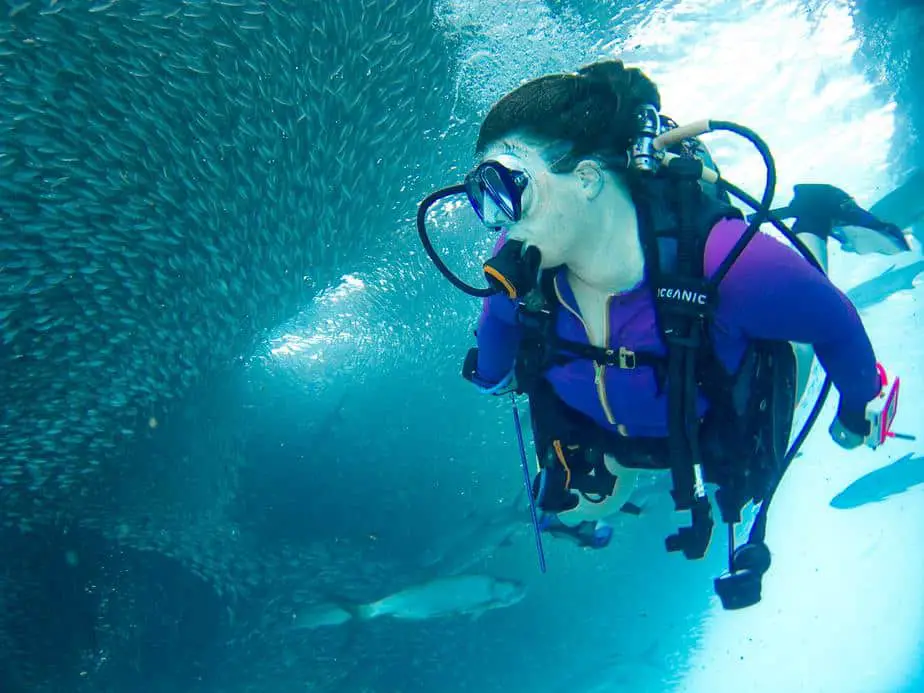If you’ve been dealing with hair problems while scuba diving and thought that getting a pixie cut or shaving your head were the only solutions, then I have some great news for you. There are plenty of things you can do to keep hair out of the way, as well as keep it hydrated and healthy, rather than taking the drastic measure of cutting it off.
What are some of the ways you can take better care of your hair for scuba diving? For instance, you could first apply a moisturizing conditioner, rub coconut oil in your hair, wear a bandana/buff, wear a diving hood, use hair ties or scrunchies, wear your hair in a ponytail, or even just hydrate your hair with freshwater before and after diving. All of these things can either keep the saltwater from drying out your hair, or safely tuck them away so that they don’t get in the way or get tangled on anything.
It doesn’t matter if you’re a man or a woman or have long hair or short hair; if you scuba dive frequently enough, you’ve probably noticed how dry and messy your hair can get afterwards. Without adequate care, your hair can get dry, brittle, frizzy; in a word, damaged. If you want to prevent that, then read on to learn more about scuba diving hair care.
How your hair gets dry and frizzy

There are a few major ways your hair can get damaged while scuba diving.
First, your hair can dry out due to the effect that salt water has on it. Salt will cause moisture to leave your hair and your skin, and it’s also why you cannot drink salt water because it’d dehydrate you more than it’d hydrate you. The longer you dive, the more water will get absorbed into your hair and hair follicles, causing it to dry out, become brittle, and possibly break.
Second, another potential problem is the sun’s UV rays which can also damage your hair and dry them out. For scuba diving, wetsuits are mandatory, however not all scuba divers dive with any head/hair protection such as a diving hood or a hair buff. If you care about protecting your hair, it may be time to start.
The combination of exposure to saltwater and UV rays will make hair extra brittle, and this causes the third way your hair gets damaged: depending on how tight the mask strap is, it can dig into your head and break strands of hair or pull them out .
Fourth, if your hair isn’t tied or covered up, it not only poses a safety risk because it can obstruct your vision or get tangled up, but it might also get damaged if it comes into contact with something sharp or gets caught on something. This last point mainly affects longer hair, however the first three points can affect hair of any length.
How to avoid hair-related issues when scuba diving
Rinse with freshwater before and after
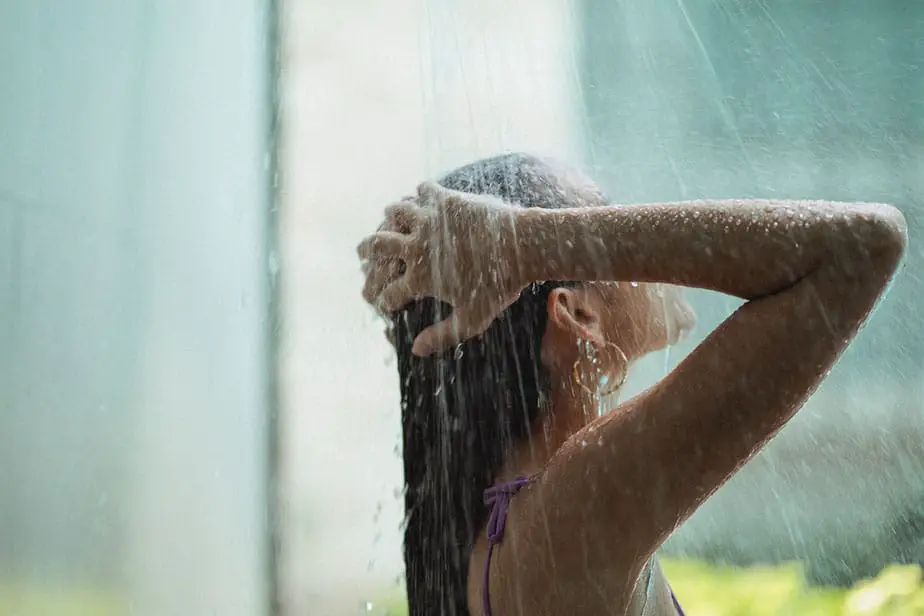
The most basic, straightforward, hassle-free thing you can do that’s been proven to work to protect your hair from drying out is to simply rinse your hair with fresh water before and after diving.
By exposing your hair to fresh water first, it will absorb that and become saturated. When it’s time to scuba dive, very little salt water will get absorbed into your freshly rinsed hair. It will also limit the damage that salt water will do to your hair.
After the dive, just as you would rinse your scuba equipment, you should also thoroughly rinse your hair again with salt water. This helps rinse off any excess salt water that is on the surface of your hair, and lets fresh water get absorbed back in your hair instead.
Rinsing your hair with fresh water is such an important step that even if you’re on your surface interval, if you have access to fresh water, you should consider rinsing it to preserve your hair.
Use coconut oil
Water and oil don’t mix; oil repels water and we can use that to our advantage by applying coconut oil into our hair to repel the salt water and prevent it from getting absorbed.
That said, your mileage may vary. Some people have found that it’s not only ineffective for their hair, but it was detrimental because it dried out their hair even more.
So before you go out and buy the biggest bottle of coconut oil you can, try a smaller one and do a test run above the surface to see if it helps or harms your hair.
Use leave-in conditioner
If coconut oil is ineffective for you, then you can try a leave-in hair conditioner instead. This has similar protective properties as oil but won’t make your hair as heavy. If you do go this route, please look for a reef-safe version such as this one. For the same reason that we should use reef-safe sunscreen, we should do everything we can to protect our oceans.
The downside of leave-in conditioners is that they tend not to last very long. In our experience, we needed to re-apply it after each dive because it had completely rinsed off each time. If you only do one dive a day, then that’s fine. If you are doing repetitive dives, you’ll need to moisturize your hair each time.
Tie your hair up
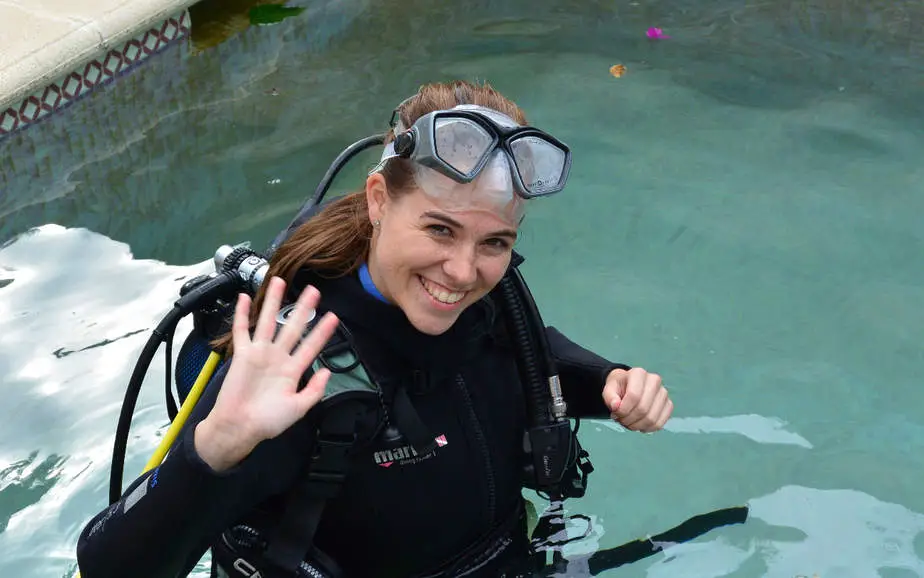
If your hair is long enough to get in the way, you need to tie it up. Unfortunately, those of you with dreams of having your hair flow freely underwater like Ariel from The Little Mermaid are going to have to put those dreams to rest. It’s not as good as it seems because it will just end up obstructing you or snagging on something, posing a serious safety risk. Plus, you’ll end up with hair that looks like a bird’s nest once you’re back on land.
To avoid all of these issues, the best thing you can do is to tie your hair up. It’s not enough to just tie it up in a ponytail because it doesn’t solve the problem entirely. Wearing your hair in a bun or braid can increase the likelihood of your hair getting tangled, and the hair tie is prone to breaking this way.
Instead, you should tie it in a reinforced ponytail. This is basically the same as a high ponytail, except instead of using one hair tie you will use multiple, adding another hair tie 1-2 inches below the previous until you’ve run the full length of your hair. How many hair ties this takes depends on how long your hair is.
It’s up to you what kind of hair ties to use. If you care deeply about ocean conservation, you can look into getting biodegradable hair ties. This way, if a hair tie breaks or falls out for some reason, you can rest well knowing that it will naturally disintegrate over time.
You can also consider scrunchies which are gentler on the hair and can come in some beautiful designs.
Cover your mask straps
Are your mask straps too tight, digging into your head and pulling your hair? A quick fix to this problem is to cover the strap using a mask cover.
These rubber straps are placed over the mask mask straps to provide a layer of protection for your head and hair. They are more comfortable, gentle, and can prevent your hair from getting damaged. They are also an easy way to identify yourself if you have a distinctive mask strap cover.
Wear a headband or dive buff
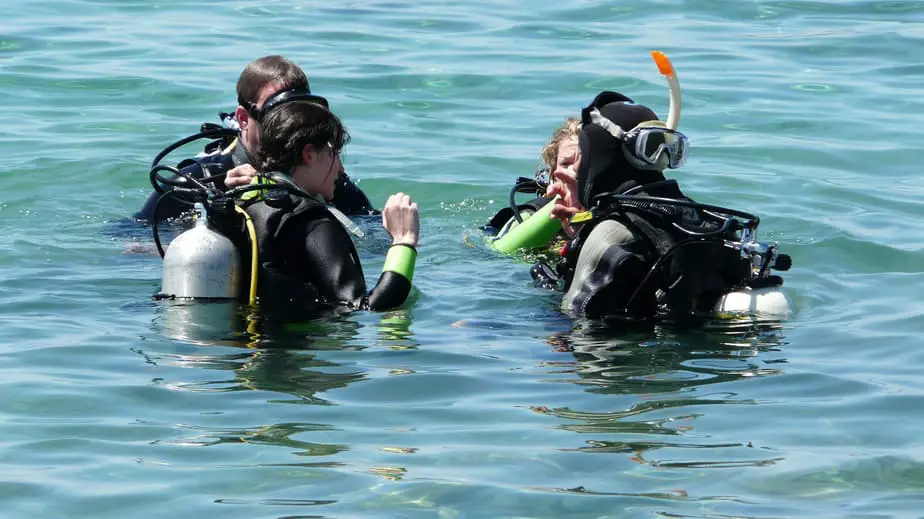
If your hair is not quite long enough for hair ties but you still want something to hold it down, then a great solution is to wear a headband. They help keep your bangs out of your way if it keeps getting in your face whenever you clear your mask.
Similarly, dive buffs are versatile accessories that protect not just your hair, but your face, head, and even neck when you’re in the middle of a dive. Since they cover so much area, they can effectively keep hair away from your gear and face.
Those of you with longer hair can also benefit from wearing a dive buff. Simply tuck your hair under it to keep it away from your face and away from the tank, BCD, and regulator as well. The large coverage of the dive buff protects a portion of your skin from the sun and wind also.
Wear a dive hood
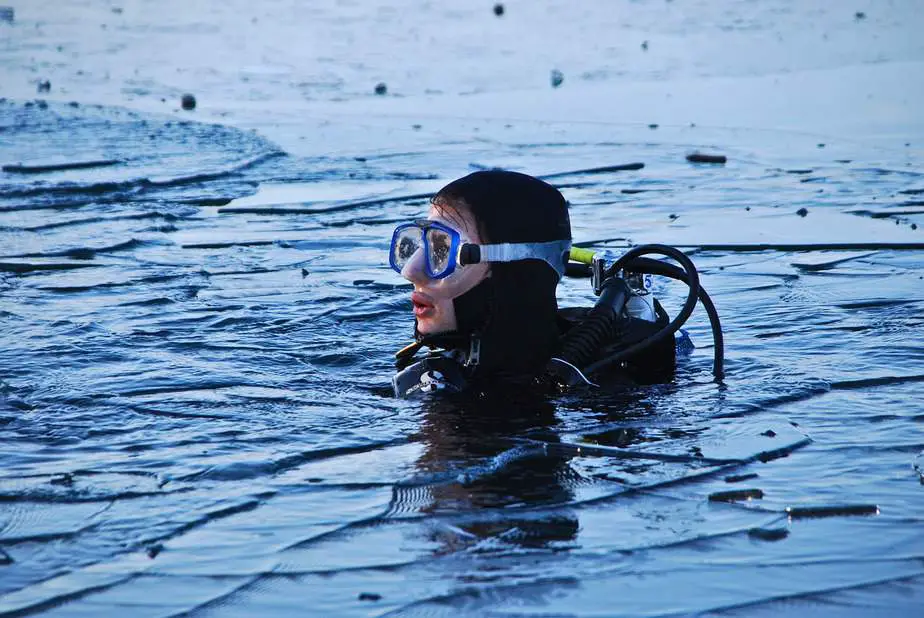
If you want some heavy-duty protection, then you should wear a diving hood. This is one of our recommended options for scuba diving/snorkeling with facial hair, and it shouldn’t be a surprise that it plays an important role in protecting your hair as well.
We love how versatile diving hoods are. Their main purpose is actually to keep your head warm in colder waters. They also offer superficial protection against jellyfish stings, sea lice, and other ocean critters that might latch onto your skin or hair while scuba diving.
As for how this is relevant to the topic at hand, diving hoods also have the added benefit of keeping your hair bundled up so they don’t get in the way and won’t snag on anything. The downside is that they need to fit very snugly, and depending on how much hair you want to cover up, they might feel somewhat constricting.
After a dive
All of our advice so far has centered on what to do before a dive to protect your hair during it. However, one thing divers overlook in their hair care is what to do after a dive to ensure your hair stays healthy.
The first thing to consider is how to dry your hair. Did you know that your traditional terry cloth towel might be harming your hair? Wet hair is vulnerable, particularly after scuba diving, so you need to use towels with softer fabrics that won’t pull or harm your hair further.
When drying your hair, avoid rubbing your hair with the towel as this can cause your hair to fray and frizz. Using a hair dryer is also not a good idea because the high heat can damage and dry out your hair as well.
Instead, look for a No products found. that is soft and very absorbent. When drying your hair with it, the correct motion is to place the towel over your head (and hair) and perform a massage motion on the scalp. For the rest of your hair that is dangling, do a squeezing motion with the towel around your hair. This will get your hair from soaking wet to damp.
Finally, let your hair naturally air dry. As we mentioned already, a hair dryer can damage your hair. If you want to speed the process up, stay in a well-ventilated room so that the increased airflow can help dry your hair.
If at any point you want to brush your hair because it’s looking messy or tangled up, we recommend using a detangling brush. A regular comb or brush would simply pull at your hair, get caught in tangles, or break off weakened strands. A specialized brush can help remove knots and tangles effectively and pain-free.
Parting words
Since everybody’s hair is different, in this article we have provided numerous scuba diving hair care tips to help people with any length of hair, both long, medium, or short. As you’ll have noticed, most of the tips were focused on prevention because there’s not much you can do after the damage has been done.
Even if you are not a fan of buying hair care products or new equipment, the least you can do is to rinse your hair with fresh water before and after a dive. If you have time and spare fresh water, consider rinsing it even between dives.
Some of the tips, such as applying coconut oil or using leave-in moisturizer, have varying degrees of success from person to person. You might want to do some trial and error by buying a smaller bottle first and testing on the surface before going out for a dive.
Note also that this list is not exhaustive; I’m sure there are many more awesome scuba diving hair care tips that I’m not aware of, however these are what I’ve learned from my own tests, reading others’ experience online, and what’s come up in random conversations over the years. This should serve as a decent starting point if you have no idea scuba diving hair care is even a thing.
Last update on 2024-07-14 / Affiliate links / Images from Amazon Product Advertising API

